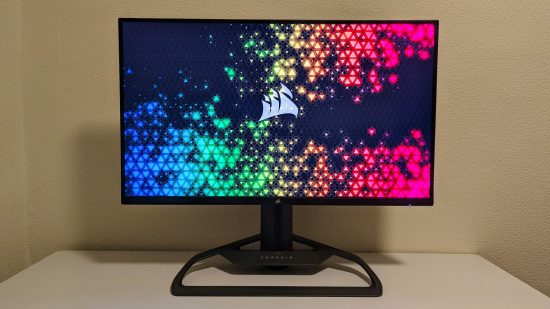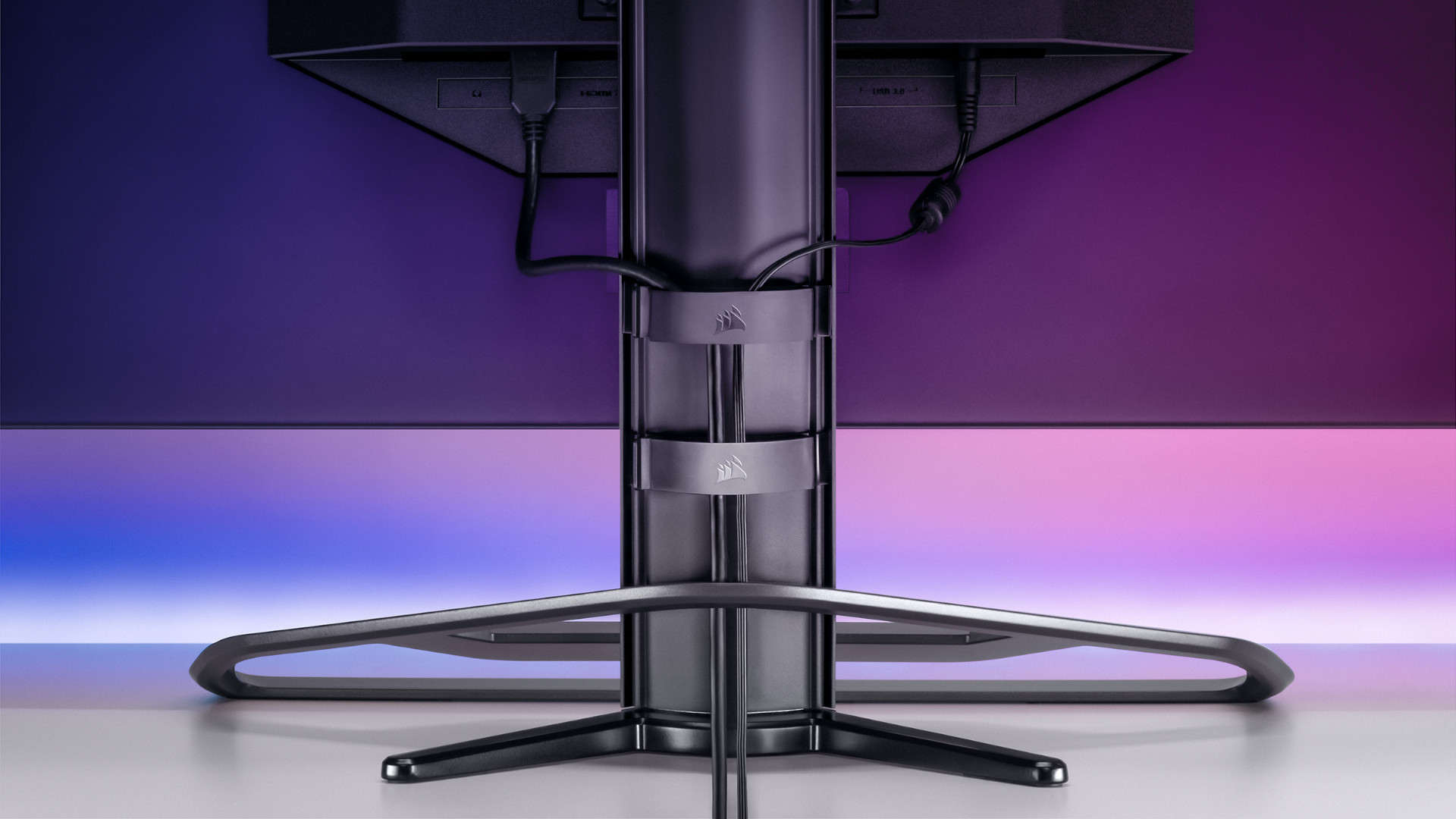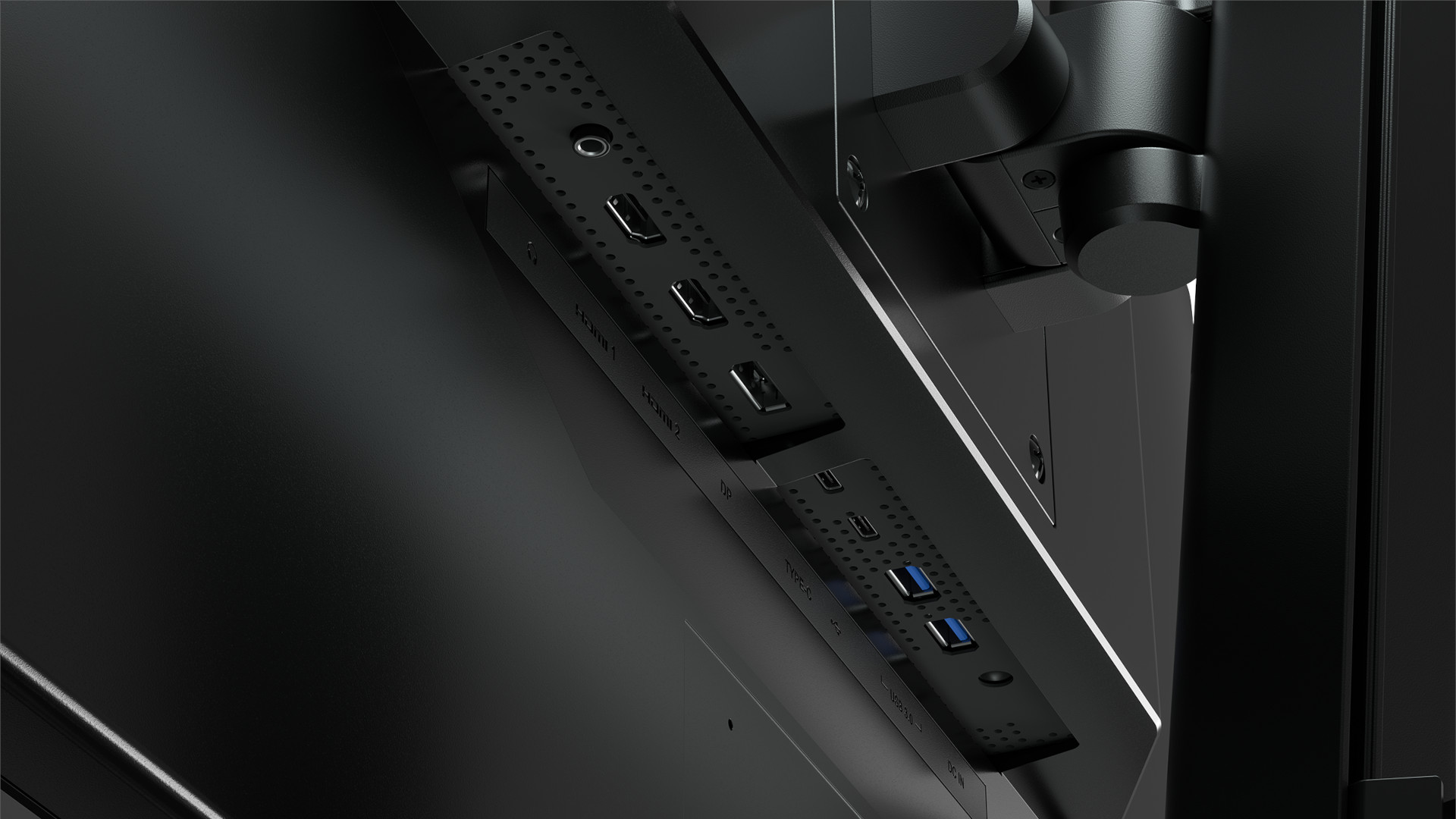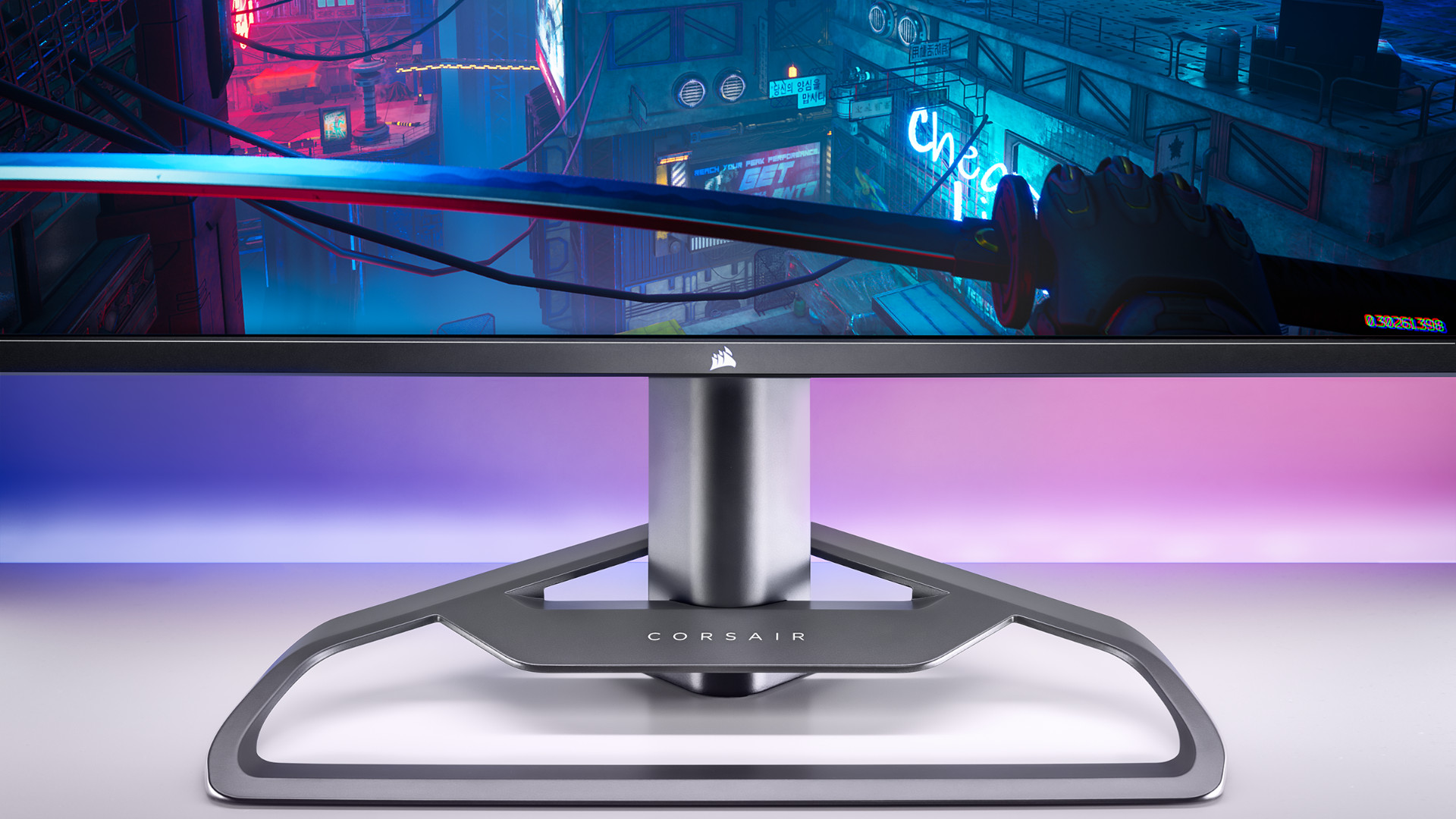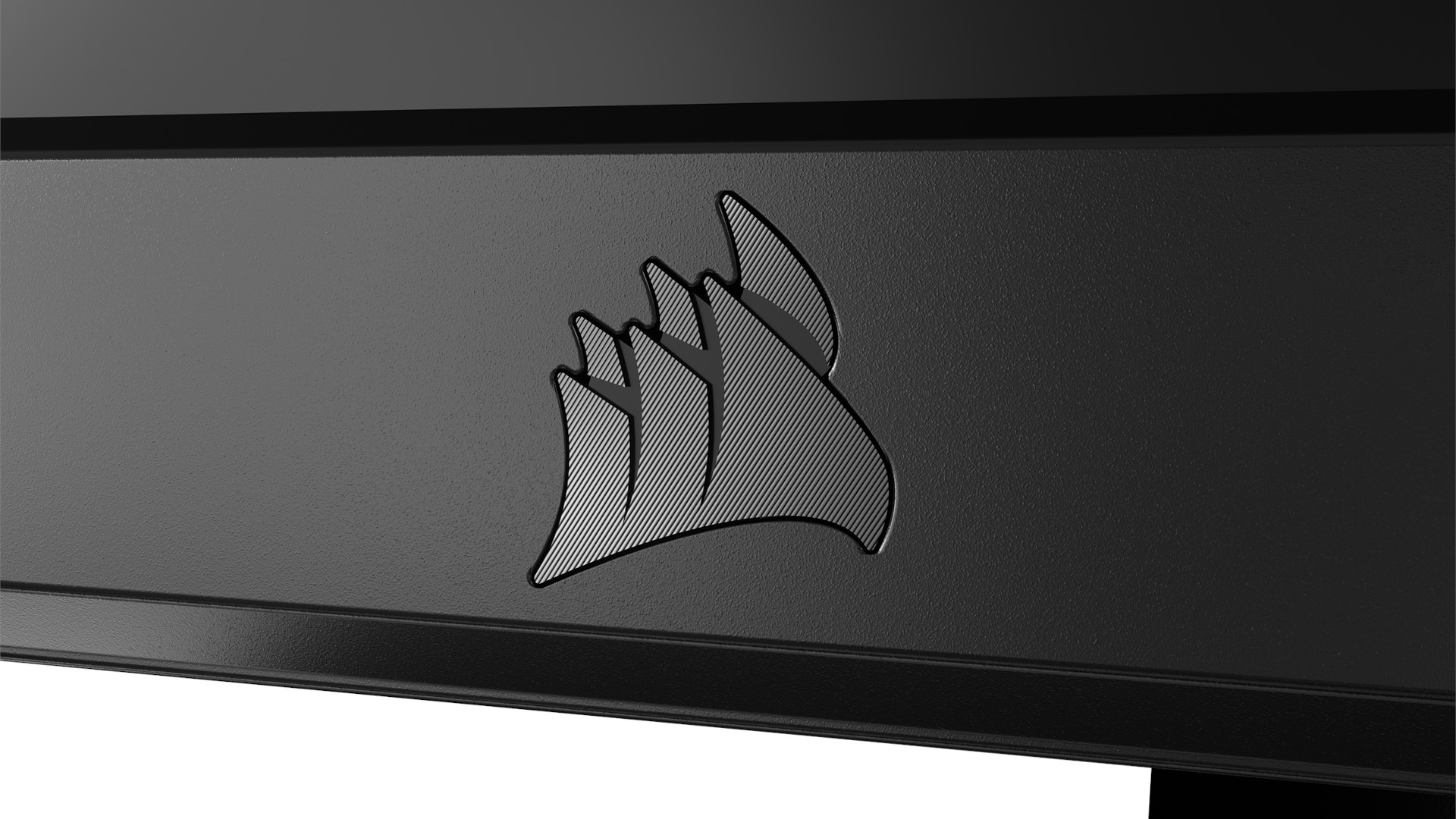Our Verdict
Strong colour performance, quality design, and solid response times make this gaming monitor a great choice, with its biggest weakness being its inability to offer a compelling HDR experience.
- High resolution and high refresh rate panel
- Produces vivid and accurate colors
- Great dynamic overdrive mode
- Lacks proper local dimming for HDR
- 1ms response time requires Adaptive Sync to be turned off
The Corsair Xeneon 32UHD144 is the first 4K gaming monitor to join the company’s relatively new line of displays, with just two other models completing the lineup. While this panel marks new ground for Corsair, the manufacturer is certainly not wanting for competition in this space, meaning that its new shiny screen needs to be both a great performer and bring something new to the market. Thankfully, it mostly accomplishes both of these tasks.
Pros
- High resolution and high refresh rate panel
- Produces vivid and accurate colors
- Great dynamic overdrive mode
- Pleasing cable management option
Cons
- Lacks proper local dimming for HDR
- 1ms response time requires Adaptive Sync to be turned off
I’ve been testing the Xeneon 32UHD144 for the past month, and a large part of me is genuinely sad about having to return our loaner unit. Swapping out my old faithful 27-inch 1440p gaming monitor for this much larger 32-inch 4K panel has greatly enhanced just about every game I’ve played on it, including countless rounds of Apex Legends and cinematic romps like Marvel’s Spider-Man Remastered. Sometimes bigger really is better.
Size isn’t the only thing going for the Xeneon 32UHD144 though, and I’ve plenty of other good things to say about it. While it has many qualities that put it in the running for the title of best gaming monitor, there are a few things that I wish Corsair had done differently.
Design
The Xeneon 32UHD144 is very plain looking for the most part, and it’s all the better for it. There’s nary a trace of any gross gamer aesthetic, nor a pointless inclusion of RGB LEDs in sight. However, to mitigate the risk of its display disappearing amid the myriad of rival matte black plastic, Corsair includes a rather unique stand. It’s undeniably the most eye-catching thing about the screen at a glance, with its heavy die-cast aluminum frame contrasting nicely against the rest of the monitor.
The stand gives the Xeneon 32UHD144 a mild dominating presence when placed on a gaming desk, although this is partially due to the amount of space it takes up. It’s not as egregious as something like the Alienware AW3423DW, Samsung Odyssey G7, or other monitors with annoyingly large tabletop-consuming legs, but I certainly feel like it encroaches perhaps just a little too much on my peripherals’ personal space. Should you feel the same, you can always VESA mount it, but this would mean abandoning one of the best things about the display.
Turning your attention to the back of the Xeneon 32UHD144, you’ll find what I can confidently describe as my favorite cable management solution on a gaming monitor. Instead of expecting you to thread your cables through a hole, Corsair has instead crafted what it dubs the ‘RapidRoute cable channel’. Along the back of the stand are four adjustable plastic tabs that keep your would-be web of wires flush against the stalk and hidden from view. This means you won’t have any droopy HDMI cords spoiling your spotless aesthetic, regardless of any ergonomic adjustments you make.
Speaking of which, the Xeneon 32UHD144 is easy to position just how you want it. There’s 110mm of wiggle room when it comes to height and 25 degrees of tilt too. Unfortunately, as is the case with most 32-inch displays, don’t expect this monitor to abandon the landscape life, as it can’t rotate.
Your preferences may differ, but the simple design of the Xeneon 32UHD144 speaks to me more than the flashier alternatives. Don’t be fooled by this simple approach, as it’s clear that the quality of the materials hasn’t suffered in the process. This is the kind of practice I wish most manufacturers would adopt, so kudos to Corsair for leading by example.
Features
Despite Corsair’s relative inexperience in the gaming monitor market compared to other more established brands, I’m quite satisfied with the feature set of the Xeneon 32UHD144, especially with it being a first-generation product of sorts.
Starting off with the basic but most important bits, it packs a 32-inch IPS panel with a 4K resolution and 144Hz refresh rate, which is where the Xeneon 32UHD144 gets its name from. Corsair immediately gets brownie points from me for giving its gaming monitors a naming scheme that doesn’t require the Rosetta Stone to decipher. It might seem inconsequential, but any move that makes buying kit for your gaming PC less confusing is a win in my book, especially when you’re spending a significant chunk of change.
I didn’t think that the jump to a 32-inch monitor would be all that significant coming from my mainstay 27-inch display, but I couldn’t have been more wrong. That additional 40% increased screen space makes a huge difference in filling up my peripheral vision, making for a more immersive experience when playing games and watching video content. Furthermore, I’m still surprised at how much sharper everything looks, with the Xeneon 32UHD144 boasting a 138 PPI (pixels per inch) that greatly helps with image clarity.
However, you’ll need a seriously powerful system to get the most out of the Xeneon 32UHD144, with my Nvidia GeForce RTX 3070 not quite powerful enough to fully drive games like Apex Legends at 4K resolution. As such, those who don’t already possess the best graphics card may want to wait for the RTX 4000 series or set their sights on a lower-resolution monitor. AMD FreeSync Premium and G-Sync Compatible certification should help you stay clear of tearing and stutters otherwise.
Should you be lucky enough to own one of the latest GPUs, you’ll be pleased to know that both DisplayPort 1.4 and HDMI 2.1 make an appearance in the I/O of the Xeneon 32UHD144. So, you’ll be able to unlock the full potential of the screen regardless of which cable you decide to use. Better still, Corsair is kind enough to include two HDMI 2.1 ports, allowing you to potentially populate the monitor with other devices, such as consoles, too.
Other connectivity options include two USB Type-C ports: one capable of operating in DP Alt-Mode for connecting to a laptop, and the other acting as the upstream connector and powering the monitor’s two Type-A ports. It’s a small thing, but I’m happy to see Corsair ditch the bulky USB-Type B connector that you often find on other screens in favour of a more convenient and modern replacement.
It would’ve been nice to see a KVM switch, especially given the support for DP Alt-Mode, but this is a minor complaint. Corsair has also decided not to include any built-in speakers with the Xeneon UHD32144, which I’m fine with. Nevertheless, the old reliable 3.5mm output is ready and waiting for anyone who prefers to connect their audio solution via their display.
While I, unfortunately, wasn’t able to try this for myself, the Xeneon 32UHD144 also features a built-in multi-mount at the top of its stand that you can use to conveniently place your webcam, key lights, or DSLR camera. It’s compatible with the Elgato Multi Mount arms too if you happen to have one of those, and makes the display more enticing if you’re a streamer.
You can access the Xeneon 32UHD144 on-screen display (OSD) via the joystick button on the back of the chassis, but all options are also customizable via Corsair iCue software if you connect the monitor to your system via the upstream port. Both methods work well enough, but the latter is easily my preferred way to tinker with settings as it’s more convenient, and the joystick can be a touch noisy to operate.
The usual suspects are tucked away in the OSD, such as brightness controls, color temperature sliders, and other image configuration options. There’s an on-screen crosshair function here too, but I honestly don’t know anyone who actually uses stuff like this. Much like the design of the Xeneon 32UHD144, Corsair has opted to make its menu clean and simple while focusing on getting the fundamentals absolutely right.
Performance
When it comes to performance, Corsair does a good job of providing a great out-of-the-box experience. By default, the Xeneon 32UHD144 is set to its ‘Standard’ picture preset, which allows the quantum dot technology found in its panel to truly shine. Images appear vibrant, and our tests indicate that they’re accurate too, so I wouldn’t recommend switching between presets save for ‘AdobeRGB’, ‘DCI-P3’, and ‘sRGB’ if you’re a creator.
For those of you that love statistics and data (like me), our unit puts in a good showing with an average Delta-E of just 0.61 and a maximum of 1.66, meaning color reproduction stays very close to the creator’s intent. The Xeneon 32UHD144 largely trips up in more accurately producing shades of grey, but its ability to cover 100% of both the sRGB and AdobeRGB and 95% of the DCI-P3 gamut accurately is commendable.
Contrast remains a weakness of IPS panels generally and the Xeneon 32UHD144 is no exception, falling short of Corsair’s advertised 1,000:1 ratio with our unit achieving a maximum of 730:1. In practice, this leads to acceptably appreciable differences between shadows and highlights, but most VA or OLED screens will likely wipe the floor with this display in this regard.
The Xeneon 32UHD144 is a pleasure to use in bright environments thanks to its solid peak SDR brightness of 440 nits, and the anti-glare coating isn’t too intrusive. However, it doesn’t get particularly dim at just 92 nits, meaning dark portions in games and video content can appear overly bright. Again, though, this is typical of IPS technology rather than a complaint specific to this gaming monitor.
Corsair advertises the Xeneon 32UHD144 as an HDR gaming monitor, but its performance is significantly lacking in this department. Boasting a Vesa DisplayHDR 600 certification, it’s not as bad as many high dynamic range pretenders out there, but its edge-lit local dimming implementation really lets it down. Sure, the screen does get brighter overall when you engage HDR, around 600 nits, but this doesn’t really matter when large portions of the screen are distractingly turning on and off in an attempt to improve contrast and black levels.
Now, let’s move on to response time metrics and motion clarity, which we’ve been able to thoroughly test thanks to our recently acquired Nvidia LDAT (Latency Display Analysis Tool).
Using the ‘Dynamic OD’ overdrive setting, grey-to-grey response times sit around 4ms, which is to be expected from a premium IPS display. It’s not quite as fast as other options out there but still very responsive. Average overshoot ranges between a tolerable 8-15%, which is good enough to keep any noticeable inverse ghosting at bay. Both ‘Normal’ and ‘Fast’ slow things down to 8ms but manage to practically eliminate any overshooting, so the latter could be the one to opt for if your preferences lean towards image quality and eliminating artifacts.
Meanwhile, ‘Faster’ reduces the average overshoot range to 3-15% but is marginally slower at 5ms. I can’t recommend anyone use the ‘Fastest’ setting as it introduces inverse ghosting and doesn’t affect response times. That is, without the aid of MRPT (moving picture response time), which, when turned on alongside the overdrive setting, allows the Xeneon 32UHD144 to achieve its advertised 1ms speed.
However, you can’t enable MRPT while AMD FreeSync Premium is enabled, meaning you need to weigh up whether Adaptive Sync or response times matter more to you. I find that ‘Dynamic OD’ or ‘Faster’ is plenty responsive and offer great motion clarity, and a marginally faster response time doesn’t outweigh the prospect of mitigating screen tearing.
Verdict
The Xeneon 32UHD144 is a solid 4K gaming monitor, boasting performance that is mostly befitting of its high-quality design. It shines brightest as an SDR display, accommodating a wide variety of color gamuts with great accuracy. Just don’t expect a great HDR experience from it, as is the case with many of its counterparts.
It’s a shame that its advertised 1ms response time requires a pretty significant trade-off, but hopefully, this can be remedied via a firmware update or successor. That said, it’s responsive enough that all but hardcore esports gamers shouldn’t have any qualms.
At $999.99 USD / £949.99 GBP, the Xeneon 32UHD144 isn’t much more expensive than many of its competitors like the MSI Optix MPG321UR-QD, but this price point will understandably be out of reach for many gamers. Corsair offers the monitor without the stand in some regions, which should save a small chunk of change.
If you’re in the market for a 32-inch 4K display with a 144Hz refresh rate that will pair well with your gaming PC and consoles, then the Xeneon 32UHD144 should certainly be on your shortlist.
